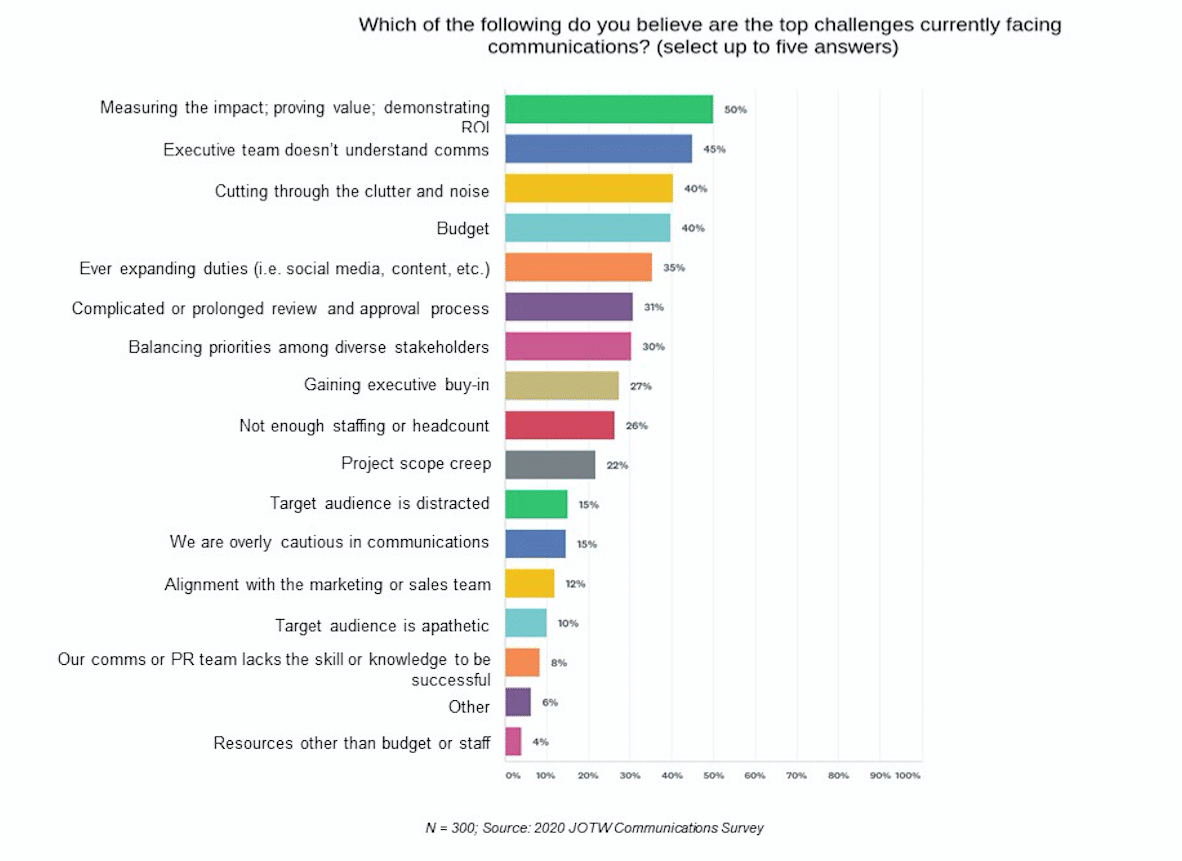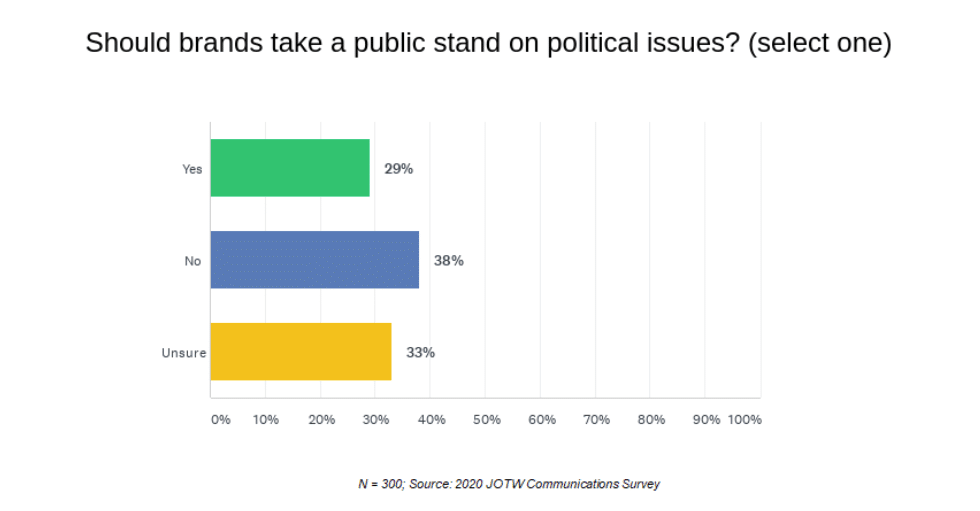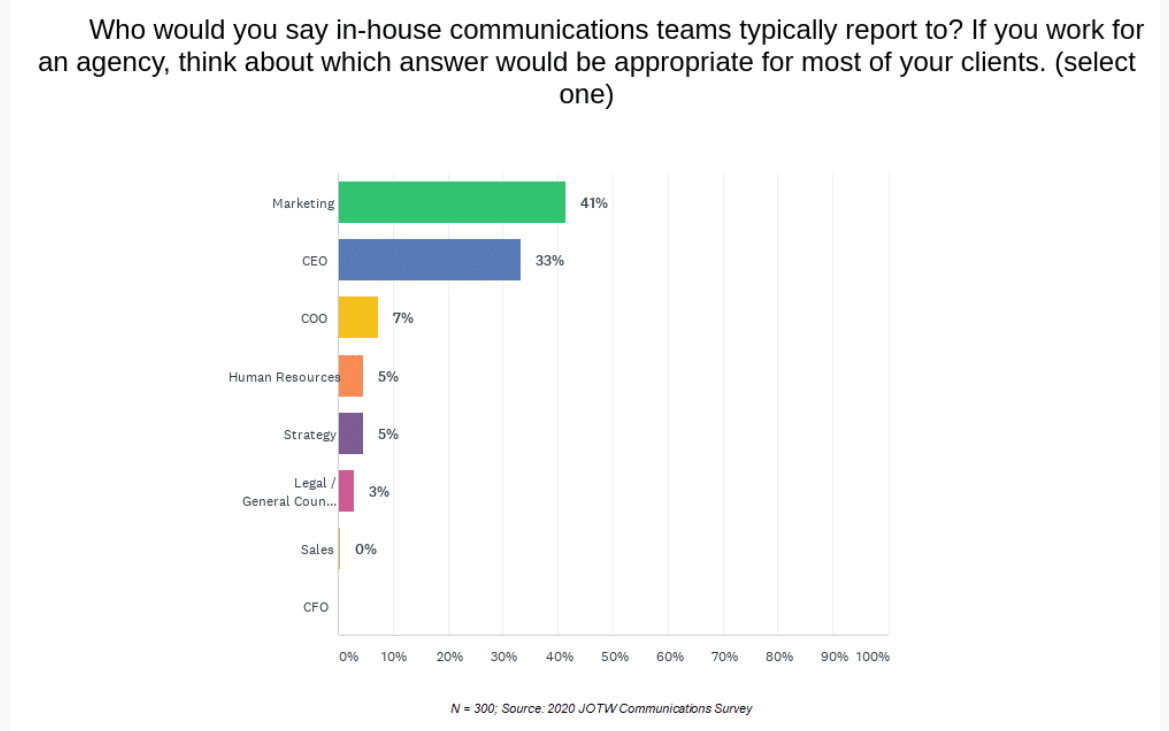Sometimes it can feel like you spend more time justifying your work than you do getting things done. That’s the sentiment that came through in the “challenges” section of the 2020 JOTW Communications Survey.
“Budget” was replaced as the top challenge facing communicators with proving value and return on investment (ROI). Second on the list—“an executive team that doesn’t understand communications”—is closely related.
Here’s a look at the top seven challenges from the survey along with some ideas for what you can do about it.
Challenge #1: Proving value
The top challenge facing communicators is measuring impact, proving value and demonstrating ROI, according to 50 percent of respondents. However, in a subsequent question, only about half of respondents “often” or “always” measure their communications efforts. The other half measures their efforts just “sometimes,” (38 percent) “rarely,” (11 percent) and even “never” (2 percent).
If you don’t have a system for measurement, create one that captures effort, engagement and outcomes. Don’t overlook anecdotes either. There’s power in a good little story about PR success. If you have such a system already, continuously seek to improve it. The survey surfaced more than 20 metrics or methods respondents are tracking as a source of ideas.
Challenge #2: Educating the executive team
An executive once asked me why a competitor was “ranking” higher in Google. When I examined the query, it was obvious to me that the executive was confusing pay-per-click advertising with organic search results.
He wasn’t the only one—you surely have confusion like this in your circle too. That was a learning moment and I used it to tactfully explained the difference. In the process, I earned both new respect for communications and cultivated greater executive buy-in.
Executives rise through the ranks from different parts of a business. Some of them haven’t picked up a marketing book (let along comms) in 20 or more years. Be as patient as you are repetitive because other surveys have shown executives that understand communications also tend to value it more.
Challenge #3: Cutting through the clutter
Some40 percent of respondents identified “cutting through the clutter” as the third greatest challenge facing PR. Competitors certainly contribute to marketplace noise, but hyper-partisan politics seem to be sucking up much of the available oxygen.
Nearly three-quarters (72 percent) of communications professionals say partisan politics makes their job harder. “Everything is seen through a political filter,” wrote one respondent.
So, what can you do? When it comes to the competition, you’ve got to challenge your organization to truly be different. Too many businesses (especially in the technology community) look the same, sound the same, and talk the same; it’s a sea of sameness.
As for navigating partisanship, that’s an interesting challenge for communicators, which is what we signed up to help solve. It seems to me, if everything is viewed through political filters, then we want to apply those filters to all communications—external and internal—before it goes out and not after.
Challenge #4: The PR budget
PR budgets have been flat for the last three years in this survey. The numbers always look something like this:
- ~25 percent expect budgets to grow;
- ~50 percent expect budgets to stay the same; and
- ~25 percent expect budgets to decline.
This year the survey was wrapping up, just as the Coronavirus pandemic was taking off. Therefore, it’s reasonable to expect the more professionals will see declining budgets. But it doesn’t have to be that way.
A straightforward way of making the case is to:
- benchmark where your organization is at;
- where the competition is at; and
- what it will take to close the delta.
For example, if you are tracking share-of-voice with your media monitoring tool, you can show an executive benchmarks for what your business earns compared to the competition. That naturally sets up a conversation about how to bridge, or perhaps extend, the gap.
Challenge #5: Expanded duties
The task list for a communicator gets longer every year. More than one-third (35 percent) of respondents identified the growth in responsibilities as fifth on the list of top challenges.
New platforms, news sites, and blogs—along with links, images, videos, and optimizations, oh, it’s endless. It’s also “unrealistic” as one respondent put it. There are limits to just how much “more with less” you can do.
Deciding what you are going to do is just one half of the strategy equation. The other is deciding what you won’t do or what can wait. For example, most organizations don’t need to be on every social media platform, so figure out where best to focus your finite resources.
Challenge #6: Protracted review and approval process
Ever notice how it merely takes a few hours to write copy and days, or even weeks, to approve it? Respondents (31 percent) placed the protracted review and approval process at number six on the list of top challenges.
I once observed the CEO of a tech company making edits to a blog post. A day later, she’d go back and make a few more tweaks. A few days later she would make still more. Where does it end? And why is the CEO spending her time like this?
Here are a few techniques for streamlining reviews and approvals:
- Define a review process with your stakeholders and boss and then publish it;
- Establish a “decision matrix” for who can approve what content by type or level; a curated blog post doesn’t require the same scrutiny as a product announcement; and
- Solicit guidelines to support your decision matrix from the legal department or corporate communications if you work in a large organization with independent business units.
Finally, “workflow” is becoming an increasingly popular term in technology circles, particularly around collaboration tools. In this example, the idea is that technology will automatically route a document for approval to a defined sequence of reviewers. Workflow, in part, reveals the bottlenecks (for all to see), which brings transparency to the process and presents an opportunity to improve efficiency.
Challenge #7: Balancing priorities among diverse stakeholders
The larger the organization is the smaller the ratio of communications professionals-to-stakeholders tends to be. Indeed, small but dependable PR teams are prone to serve many leaders, product lines and business units. That’s perhaps why balancing priorities among diverse came in at number seven (30 percent).
It’s wonderful to be needed but you can’t possibly get to it all, so focus on process and data collection to help provide transparency and equity. This brings transparency and clarity for the whole team—to illustrate who is asking for what, when and how long it takes.
The 3rd annual survey was a joint-effort between Ned’s Job of the Week (JOTW) newsletter and Sword and the Script Media. A total of 300 professionals took the survey: 92% report having 11 or more years of experience; 52% of respondents are in-house communicators; and respondents come from more than a dozen different industries. A copy of the report is freely available for download as a PDF on SlideShare.












